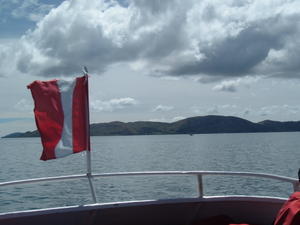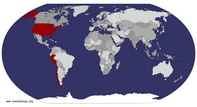Advertisement
Published: February 19th 2007

 On the boat, Inka II
On the boat, Inka II
In the middle of Lake Titicaca with the Peruvian flag blowing in the wind...NOTE: I am really behind on the blog, but am working on getting caught up. The emails from travelblog haven´t been working, so be sure to check and read all the new posts.
Alright, we left Cuzco early in the morning on Sunday, January 21st and headed to Puno, which is on Lake Titicaca about 6-7 hours from Cuzco. After the exhausting trek to MP, we did not want to wake up early on Sunday and head out, but we sucked it up and did.
The drive from Cuzco to Puno was fastinating and was one of the few times besides the hike that we´ve seen the Peruvian countryside because we usually take overnight buses everywhere. It´s so interesting because you really learn and see the most about a country by driving through the places BETWEEN all the cities and towns that most people visit. I wish I could have taken pictures out of the window, but since I could not, I will do my best to describe it.
As we left Cuzco, the scenery looked similar to what it was as we left MP. There were high hills surrounding us and terraces for farming could be seen

 Best Meal of the Trip! Llama?
Best Meal of the Trip! Llama?
The woman in the pic makes the best meat and potato thing EVER... and it only cost 30 cents! Of course, we didn´t ask what kind of meat it was, but I´m pretty sure it was llama or alpaca. Yum!pretty high up the mountains. The hills were generally green with rocks peaking out of the overgrown forest... making you take a second look wondering if there could be another undiscovered Incan town hiding in the overgrowth. As we drove on, the hills got lower and they looker drier or at least with less evidence of agriculture.
We passed many farms along the side of the road and many pastures where livestock (mostly cows and llamas/alpacas) were grazing in the fields. Every so often you could spot a house on the side of the road... although in America it would most likely be called a shack. They were usually built out of clay or mud bricks, sometimes wood, with flimsy roofs and very short, since their inhabitants are not very tall. We noticed some local farmers walking by the side of the road: Most of the men wore dark pants and an old button up or cotton shirt. The women were more distinctively dressed with black skirts and usually carrying something in a multicolored carrying sash tied around her body and resting on her back. Most of the men, women and children we saw looked like Nativos, or with
very little European blood. Their features are dark skin, straight and dark hair, short in stature, the woman were usually a little plump and their faces were also distinctive with narrow black eyes and a square face.
I am trying my best to desribe the countryside and show the personality it has without using any pictures. It is also different from what we´ve seen since the inhabitants of the farms are noticeably more indigenous looking in features and dress and the way they live is different than those who live in the city, although in some cases the evidence of poverty is identical.
As we continued to drive, the hills became less and less imposing and the farms started to blend together... so I fell asleep.
Once we arrived in Puno we were snagged at the bus station by hostal hagglers and ended up finding Olga who hooked us up with the Manco Copac Inn, which is a new hotel named after a famous Incan king. After sleeping in tents and shady hostels, we felt like ballers in this place with a proper bed, pillows, a nice bathroom and a proper reception area. As we drove from

 Hug and Shoot on Lake Titicaca
Hug and Shoot on Lake Titicaca
Ok, not the most flattering pic of me, but cool cause we took it ourselves on top of the boat.the bus station into town, we saw a city very different from both Lima and Cuzco. Where we stayed and the surrounding area was much less touristy than what we were used to and also a lot less crowded and bustling than Lima. There were stores and services of all kinds lined on each block, with people living above or next to them. We also saw Craigslist Puno... basically a wall where people wrote in black magic marker - job posting, houses for rent, people selling skills and services. It was pretty cool.
The first thing we learned about Puno would turn out to be one of the best: Really good, cheap food. As we wandered around looking for a restaurant we came across a woman selling meat on a stick with a potato on top. It smelled AMAZING and looked good too. Even better, one of these things was only one nuevo sole... about 30 cents! Of course, we weren´t sure exactly what kind of meat it was and we didn´t want to ask, but because of the price we are pretty sure that it was llama. It also tasted nothing like any other meat I´ve ever had.

 The Floating Islands
The Floating Islands
Or the "Islands of the Uros"But it was delicous. I had two. We learned that we would pay between 2 and 4 soles for a full meal here in Puno... soup, 1/4 of a chicken with salad and potato and a cup of tea. That means about 1.25 maximum for a really good meal. I love this place!
Next, we walked to the Plaza de Armas, which was much smaller than the ones in Lima, Cuzco and Arequipa that we have seen so far. But honestly, when traveling through South America, once you´ve seen one Plaza, you´ve pretty much seen them all. Although to our surprise, all of the sudden we heard blasting trumpets and a parade began marching through the streets around the plaza. They were playing catchy tunes while cultural groups were dancing along... mostly dressed in pants with matching shirts, but a couple of folks were in traditional peruvian getups.
After watching the parade for a couple of minutes, we got ice cream and sat in the Plaza taking a breather from the crazy couple of days we had. Of course, once we got back to the room we saw something we hadn´t seen in a while... cable TV. Since

 Uros Boat
Uros Boat
Made entirely of reeds.the NFL playoffs were on, I pretty much counted Jay out and took my time showering and journaling while he watched. Neither one of us made it through the game, and by 8:30pm we were passed out. The strain of MP had finally gotten to us and we just slept like champs, which was a good thing since we had an early start the next day too.
On Monday, January 22nd, we were picked up by Inka Tours to take a boat out onto Lake Titicaca, visit the Floating Islands, and the large island of Taquile, which is actually in the middle of the lake about 2 or 3 hours from Puno. We set out with a cool group of people of all nationalities, with a guide that seemed to speak a little of every language under the sun, but mostly English and Spanish.
I will let the pictures speak for themselves, but a couple of explanations about our day on Lake Titicaca.
The Floating Islands or Islas Uros:
These "Islands" are actually entirely contructed out of the reeds we saw growing the in lake on our way to the islands, about 30 mins from Puno.
There are about 50 islands close together on the lake, inhabitated by the Uros people for over a thousand years. As the Incans and pre-Incans tried to conquer them, the Uros people decided to leave Puno (where they had migrated to from what is now Bolivia) and actually live in the middle of the lake. They dry out these reeds and use them and what looked like mud to construct the "island" that floats on the lake. They also use it to build houses, boats, and even use the fibers for rope. It is really amazing to see, so check out the pics for a better idea of what I am describing.
The Uros actually still speak the language of their ancestors, but also Spanish and a little Quechuan (language of the Incas). They are also very traditionally dressed. They are mostly fishermen and women since they do live in the middle of a lake. hehe. They also go to Puno about every week to visit the market, sell their fish and crafts and buy things they cannot get or grow on the islands. Each island lasts about 50 years before it starts to sink and when that happens,
the can build a new one in a short time and just move to the new one. I promise you this is for real... even though I saw it with my own eyes and don´t believe it.
Next, we went back on the boat for another 2 hours or so and visited the island of Taquile, which is actually a real island in the middle of the lake. The inhabitants speak Quechua and are a mix of the same group the Uros came from, and the Incans that conquered the island during the height of the empire, though they speak only Quechua and Spanish. We walked arount the island, observing the farms and homes built up on the hill of the island.
We also visited the Plaza, which was similar to most plazas in South America - with a church, the municipality and market where the locals sold their crafts. It was very interesting to see the native culture merge (or clash?) with the obvious influence of the Spanish colonialization in the plaza.
We learned that the dress of the Taquiles is very specialized. The men wear black pants and white shirts, but whether or not they
are married is indicated by weather their hats are solid or not. The women all wear black skirts with yellow or red sweaters over a white shirt. I don´t know why, but this is just their traditional dress.
As we took the boat back to Puno, we just took in the beautiful scenery and relaxed on top of the boat. Amazing. It was just peaceful to look around at the cool blue water while the wind was blowing in my hair. What a great day.
Advertisement
Tot: 0.04s; Tpl: 0.013s; cc: 10; qc: 18; dbt: 0.0174s; 1; m:domysql w:travelblog (10.17.0.13); sld: 1;
; mem: 1.1mb






















Ken
non-member comment
Hey Fisher!
Hey Rachel! I miss you! Looks like you are having a great time. Say hi to Jay=) much love, Ken